
HOME
INTRO
SYMBOLS
ALMANAC
ECONOMY
GEOGRAPHY
STATE MAPS
PEOPLE
FORUM
NEWS
COOL SCHOOLS
STATE QUIZ
STATE LINKS
BOOK STORE
MARKETPLACE
GUESTBOOK
CONTACT US


You may double left-click on a word on this page to retrieve its definition. Tweet Follow
Utah State Folk Dance
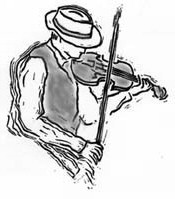
Play that fiddle!
History indicates that early Mormon pioneers settling in Utah, loved to dance. It's reported by Andrew Love Neff, in his book History of Utah 1847-1869, that
"The Mormons love dancing... almost every third man is a fiddler, and every one must learn to dance. In the winter of 1854-1855, there were dancing schools in almost every one of the nineteen school houses, and necessarily so much more attention to dancing involved so much less attention to study."
"Let it be remembered that only square dances were indulged in, that the gatherings were opened and closed with prayer, and that preachments were often interspersed with dancing, a happy combination of religion with pleasure and enjoyment..."
(Neff, History of Utah, 1847-1869 , 1940)
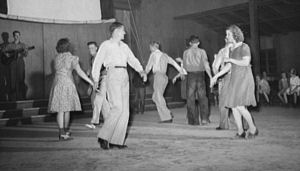
Saturday Night Square Dancing (1942)
By the mid 20th century, modern Western square dance clubs were sweeping across the nation, providing Americans with a wealth of social interaction and wholesome activity. The growth of these clubs also proved to be quite lucrative.
In the early 1970s, modern Western square dance clubs across the country collaborated to have the square dance declared the official American folk dance of the United States of America. This was an ambitious undertaking peaking on June 1, 1982 when President Ronald Reagan signed Senate Joint Resolution No. 59 designating the square dance "the national folk dance of the United States of America for 1982 and 1983.
From this point, a change in strategy was announced by national square dance organizations. The decision was made to obtain official designation at the state level to leverage the effort at the national level. Read more about this campaign.
At the onset of 1994 seventeen states, or eighteen depending on the source, had declared recognition of the square dance as official in some capacity. Arizona's accomplishment, the most tenuous, was a proclamation from the governor.
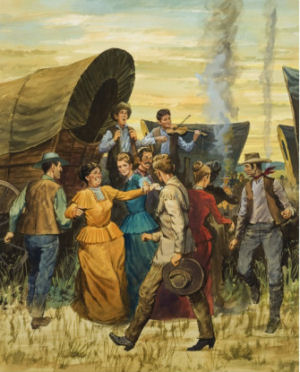
Utah State Folk Dance: Square Dance
Posters and Photographs
During 1994, square dancers in an additional four states persuaded legislators to honor the square dance. Utah was one of those states.
Utah square dancers were fortunate enough to be able to enlist the help of Senate Majority Leader Lane Beattie in their campaign to make the square dance the American folk dance of the State of Utah.
On February 14, 1994, Senator Beattie's bill, Senate Bill No. 306 (SB306), was read for the first time and submitted for consideration by the Utah Senate where it was referred to the Senate Rules Committee for evaluation. Accompanying the bill were copies of legislation from early adopters of the square dance to serve as support for Utah's SB360.
Evidently, Senator Beattie thought that earlier recognition of the square dance by a large number of other states would help to make a case for the designation in Utah. Endorsement of the square dance by the other states must have been seen as an important selling point.
Often, states elect an item that is unique to their geography or history or culture to serve as a symbol or emblem of the state. In the case of the official folk dance, "uniqueness" as an aspect of the designation seemed to mean little.
From the little documentation we have concerning the legislative process undergone by Senate Bill No.306, it appears that the legislation moved through both houses of the Utah State Legislature without any interference. After introduction in the Senate, SB306 was approved unanimously in a mere four days. It was then routed to the State House of Representatives for evaluation.
In the State House of Representatives, SB306 was finally approved within two weeks.
Governor Michael Leavitt took some time to sign the bill, but when he did, on March 17, 1994, the square dance became the official "folk dance of Utah."
SQUARE DANCING AS THE OFFICIAL STATE FOLK DANCE
1994
GENERAL SESSION
Enrolled Copy
S. B. 306By Lane Beattie
Scott N. HowellAN ACT RELATING TO STATE AFFAIRS IN GENERAL; PROVIDING A DEFINITION; AND DESIGNATING SQUARE DANCING AS THE STATE FOLK DANCE.
THIS ACT AFFECTS SECTIONS OF UTAH CODE ANNOTATED 1953 AS FOLLOWS:
ENACTS:63-13-8.1, UTAH CODE ANNOTATED 1953
Be it enacted by the Legislature of the state of Utah:
Section 1. Section 63-13-8.1, Utah Code Annotated 1953, is enacted to read:
63-13-8.1. State folk dance.
(1) As used in this section, "square dancing" means the folk dance which is called, cued, or prompted to the dancers, and includes squares, rounds, clogging, contra, line and heritage dances.
(2) Square dancing is selected and designated to be the folk dance of Utah.
The square dance is a popular type of folk dance in the United States. This dance for four couples, or groups of four couples, is performed in a compact framework of a square, each couple forming a side. Traditionally accompanied by a fiddle, accordion, banjo and guitar, the couples perform a variety of movements prompted by the patter or singing calls (instruction) of a "caller". Cooperative movement is the hallmark of well-executed square dancing.
Square dancing is to be distinguished from related dances called contra or longways dance where couples stand double file in a line and from round dances where couples stand in a circle. The origin of the square dance can be traced to English derivation and to the stately French cotillion performed in square formation that was popular at the court of Louis the fifteenth later replace by the quadrille (another square dance).
According to the PIONEER: Utah's Online Library administered by the Utah State Library:
In 1994, the Utah State Legislature designated Square Dancing to be the state folk dance of Utah (Utah Code). The Utah Code states "...square dancing means the folk dance which is called, cued, or prompted to the dancers, and includes squares, rounds, clogging, contra, line, and heritage dances".
("PIONEER: Utah's Online Library")
Note that the definition of square dancing legislated by Utah expands the definition of traditional square dancing. This expanded, some would say corrupted, definition of square dancing is currently promoted and supported by Western square dance organizations. Read more here.
Utah Law
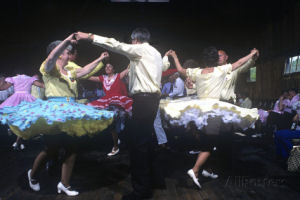
Utah State Folk Dance: Square Dance
Posters and Photographs
The following information is excerpted from the Utah Code, Title 63, Chapter 13, Section 63.13.5.5.
All of Utah's state symbols are listed under Section 63.13.5.5 in a numerical order. Utah's state folk dance is, at the time of this writing, listed as number 10.
Title 63 -- State Affairs in General
Chapter 13 -- Miscellaneous Provisions
63-13-5.5. State symbols.
63-13-5.5. State symbols.
...
(10) Utah's state folk dance is the square dance, the folk dance that is called, cued, or prompted to the dancers and includes squares, rounds, clogging, contra, line, and heritage dances.
...
Sources...
Neff, Andrew Love. History of Utah, 1847-1869. Salt Lake City: Deseret News, 1940. Print.
Senate Journal: Fifth Extraordinary Session of the Fiftiteh Legislature. Salt Lake City: Utah State Legislature, 1994. Print.
Shearer, Benjamin F. and Barbara S. State Names, Seals, Flags and Symbols: A Historical Guide Third Edition, Revised and Expanded. Westport, Conn: Greenwood Press, 3 Sub edition, 2001.
"Utah State Folk Dance - Square Dance." PIONEER: Utah's Online Library. Utah State Library Division. Web. 11 Jan. 2005.
Additional Information
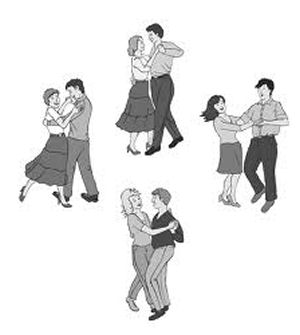
Utah State Folk Dance: Square Dance
Square Dancing 101: Square dancing basic including positions, formations, moves, and a glossary.
Video Square Dance Lessons Online: Video Square Dance Lessons Online and on DVD from Cyberpoint Marketing, LLC.
A Brief History of Square and Round Dancing: by Herb Egender.
Square Dancing: The Historical Geography of an American Folk Custom: by Richard M. MacKinnon, Allan Hancock College, Santa Maria, California.
Square Dance History Project: Website devoted to the documenting the history of square dancing with historical documents and an emphasis on imagery as much as possible.
History and Heritage of Modern American Square Dancing: A summary of the essays by Dorothy Shaw, Bob Osgood and Kenny Reese.
The State Folk Dance Conspiracy: Fabricating a National Folk Dance: by Judy Mangin - Originally published in the Old-Time Herald, v.4(7) p.9-12, Spring 1995.
National Folk Dance Effort Moves Forward: We're On Our Way Now, So Let's Make a Lot of Noise!: United Square Dancers of America National Folk Dance Committee.
The Square Dance Legislation Collection: American Folklife Center 1984/024, Compiled by Michelle Forner, Library of Congress, Washington DC, December 1994
Official website: The Associated Square Dance Clubs of Utah.
State dances: Complete list of official state dances from NETSTATE.COM
More symbols & emblems: Complete list of official Utah state symbols from NETSTATE.COM.
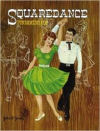
Square Dance Fundamentals
John W. Jones
Square Dance Fundamentals, John W. Jones. 208 pages. Publisher: BookSurge Publishing (February 5, 2007)
While there have been countless fun books written on square dancing, Squaredance Fundamentals was the first to cut to the chase. There is no interesting history of square dancing, there are no entertaining anecdotes, just the nuts and bolts of how to square dance. Revolutionary illustrations show the dancer’s point of view, not just the spectators’ viewpoint. Dancers can, without turning on their heads, glean from the detailed illustrations exactly what they need to be doing with their hands, feet, etc. Each dancer can effortlessly grasp the material and easily retain it. Renowned master caller/teacher, Marshall Flippo, assiduously assisted the author in establishing the very first guidelines for standardized “Basic Maneuvers” which would enable square dancers to dance gracefully with any group, anywhere.
No one shows you better how to execute the maneuvers than John W. Jones with his super simplified instructions and state-of-the-art illustrations in Squaredance Fundamentals - the gold standard for over 37 years.
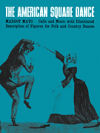
The American
Square Dance
Margot Mayo
The American Square Dance, by Margot Mayo. 116 pages. Publisher:Music Sales American (September 1, 2006)
You can have fun square dancing and you'll learn how to dance the figures and even learn how to call a square dance with Margot Mayo's classic manual, The American Square Dance. Here is the basic book for square dancers containing all of the essentials for many hours of enjoyment. An illustrated glossary of square dance terms shows all of the basic square dance figures – promenade, allemande left, do-si-do, etc. Complete instructions, calls and illustrated figures for 13 of the most popular American square dances appear, plus the music all ready for your pianist and fiddlers to play.
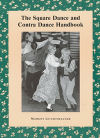
The Square Dance and
Contra Dance Handbook
Margot Gunzenhauser
The Square Dance and Contra Dance Handbook: Calls, Dance Movements, Music, Glossary, Bibliography, Discography, and Directories, by Margot Gunzenhauser. 320 pages. Publisher: McFarland & Company, Inc., Publishers; annotated edition (July 28, 2010)
This comprehensive guide to traditional style square and contra dancing, sometimes referred to as "country dancing," covers both music and style and gives background information on various dance types and calling techniques. Ninety dances, presented in chapters according to type (mixers, progressive circles, contra, Southern mountain style, squares and others), in a wide variety of formations are described with drawings and diagrams for many of the movements. A glossary of terms, a directory of addresses (organizations; vendors of books, recordings and audio equipment; and dance camps), and an annotated discography and bibliography are also provided.
A glossary of terms, a directory of addresses (organizations; vendors of books, recordings and audio equipment; and dance camps), and an annotated discography and bibliography are also provided.
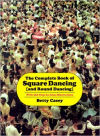
The Complete Book
of Square Dancing
(and Round Dancing)
Betty Casey
The Complete Book of Square Dancing (and Round Dancing), by Betty Casey. 208 pages. Publisher: University of North Texas Press (June 1, 2000)
This book includes: 50 basic movements, 35 advanced movements, variations, dances that are a part of the American heritage, Contra and Round Dances, polkas and reels, and calls, past and present.
“Square dancing is friendship set to music,” says author Betty Casey. Just take four couples, old or young, put ’em on a good floor, turn on the music, and you’re all set. Whether you’ve done it before or you’re just starting out, this book tells you everything you need to know—85 basic movements used all over the world, the spirited calls unique to square dancing, the costumes and equipment that are best, and music (from “Red River Valley” to “Mack the Knife”) that will set your feet in motion.
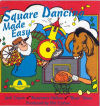
Square Dancing
Made Easy
Square Dancing Made Easy, Grade level: K-6. Audio CD (September 1, 1995), Number of Discs: 1, Label: Educational Activities, Inc.
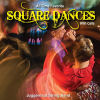
All Time Favorite
Square Dances
All Time Favorite Square Dances with Calls, Audio CD (September 8, 2009), Number of Discs: 1, Label: KADO, Run Time: 60 minutes.
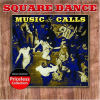
Square Dance Music
& Calls
Square Dance Music & Calls, Audio CD (November 21, 2006), Number of Discs: 1, Label: Collectables Records.
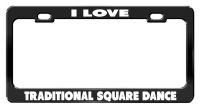
Black Metal
License Plate Frame
I LOVE TRADITIONAL SQUARE DANCE Black Metal Car Accessories License Plate Frame, This high quality license plate frame is made of metal, and it's the best quality item of its kind in the market. The lettering and art work are done by waterproof vinyl on the license plate frame and it will last for many years without any damage. It will not get brittle or cracked. It fits on all USA and Canada vehicles. It measures 12.5" X 6.5" and is durable to last under all weather conditions.
- Heavy Duty High Quality Metal License Plate Frame.
- Perfect Gift idea And Easy Installation.
- Rust, Corrode And Fade Free For Many Years.
- Fits all US and Canada License Plates.
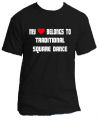
Traditional Square
Dance T-Shirt
MY HEART BELONGS TO TRADITIONAL SQUARE DANCE, This is a high quality pre-shrunk t-shirt that will not shrink or fade. It's comfortable, casual and loose fitting and will quickly become one of your favorites. It wears and looks well on anyone. It is cured with a heat treatment process to ensure lasting durability.
Brand New High quality preshrunk tee-shirt that will not shrink or fade. Double-needle stitched hemmed sleeves and bottom. Highest quality printing materials. 50% Cotton, 50% Polyester preshrunk blend. Soft, comfortable and weighs 6 oz.
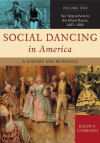
Social Dancing in America: A History and Reference (Volume One), by Ralph G. Giordano. 380 pages. Publisher: Greenwood (November 30, 2006)
Social Dancing in America examines the role of social dancing in daily life from the first settlements in 1607 through the birth of the nation in 1776 and into the beginning of the 21st century. This two-volume set provides a history of American social dances including the Photographs, posters and prints Reel, Square Dancing, the Lindy Hop, Rock 'n' Roll, the Twist, Disco, Breakdancing, and Hip-Hop. Social Dancing in America places social dancing in a historical, social, cultural, and political context.
Volume 1 explores the integral role that social dancing played in the lives of Americans from the first settlements in 1607 through the 19th century, often in the most unlikely of ways. For example, readers may be surprised to learn that George Washington was a well-known aficionado of social dancing, and that he incorporated the etiquette and manners of dances such as the Minuet as a means of diplomacy to secure European allies during the Revolutionary War. After his death, Americans continued to celebrate his birthday with a grand ball that included dancing.
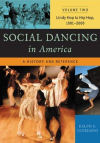
Social Dancing in America: A History and Reference (Volume Two), by Ralph G. Giordano. 428 pages. Publisher: Greenwood (November 30, 2006)
Volume 2 places social dance in a 20th-Century context, illustrating how social dancing itself paralled the social, economic, and cultural traditions of each era. For example, segregation and the Jim Crow mentality was cemented in place all over the United States, and for much of the century, dancing and dance halls were strictly segregated. Segregation forced a mass migration north, and with it came the transformation of Delta Blues music into an American original—Jazz. Jazz gave birth to the Charleston, and later evolved into Swing, which created the Lindy Hop. Later, with the advent of television, programming such as American Bandstand, Soul Train, Dance Fever, and MTV greatly influenced dance styles and modern trends such as Rock 'n' Roll, Freestyle, Disco, Breakdancing, and Hip-Hop.

